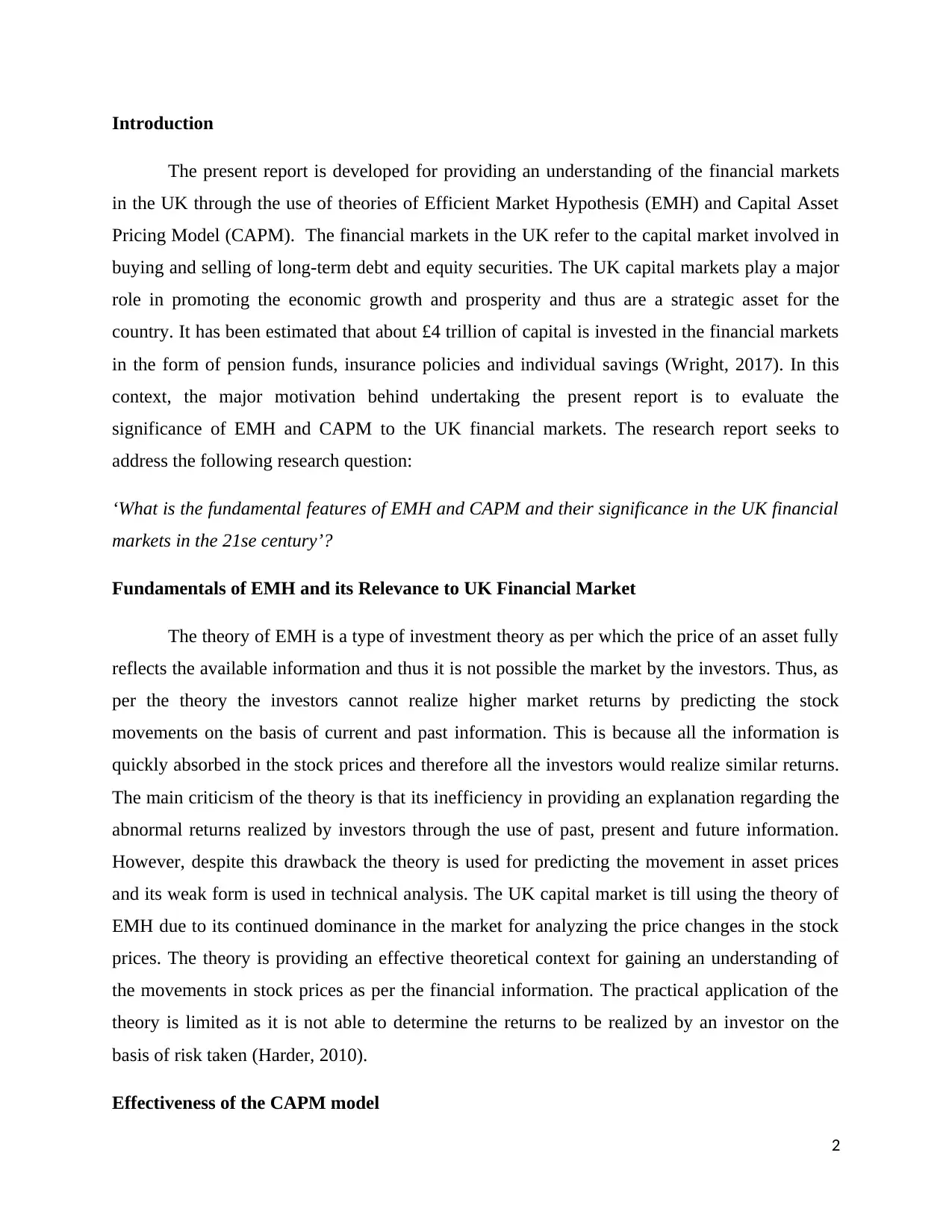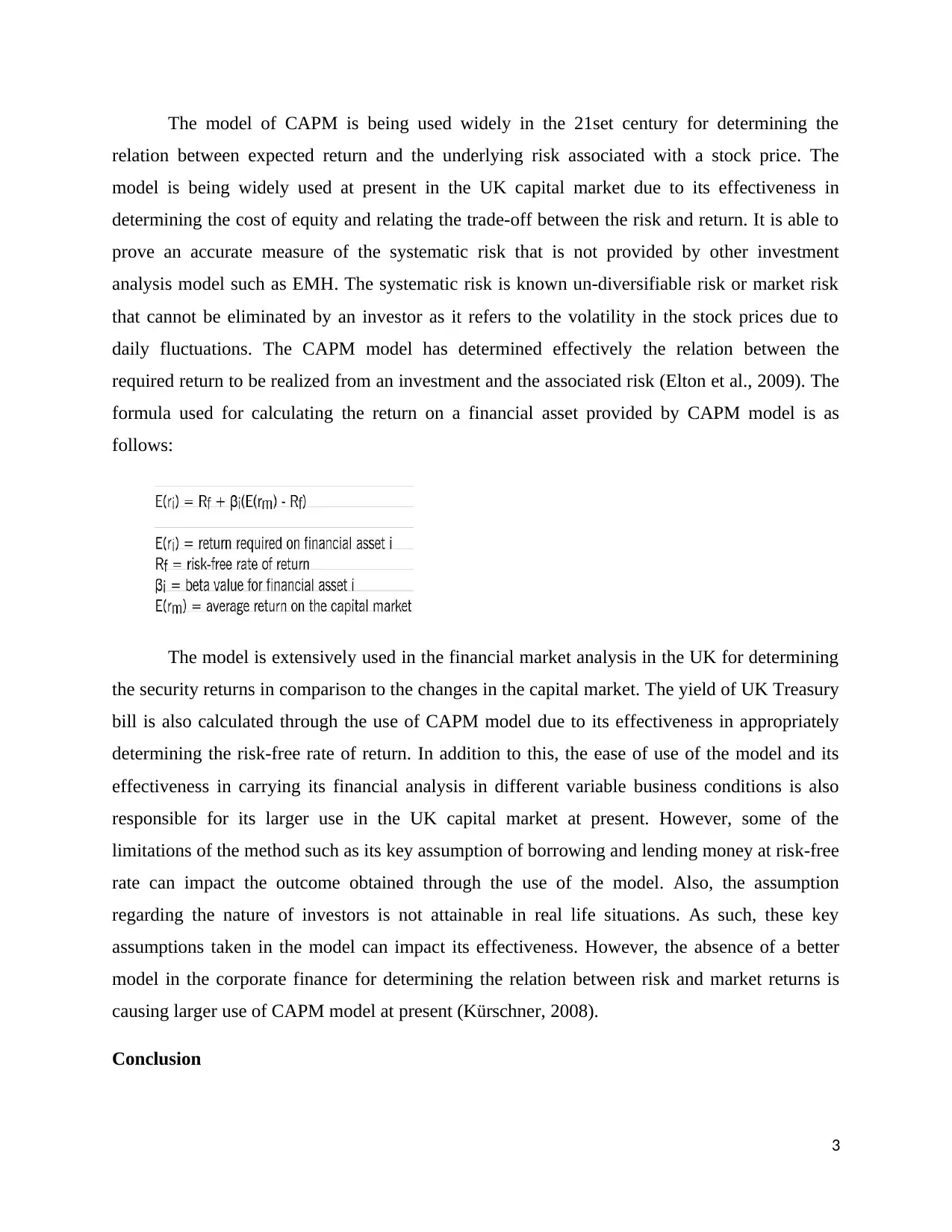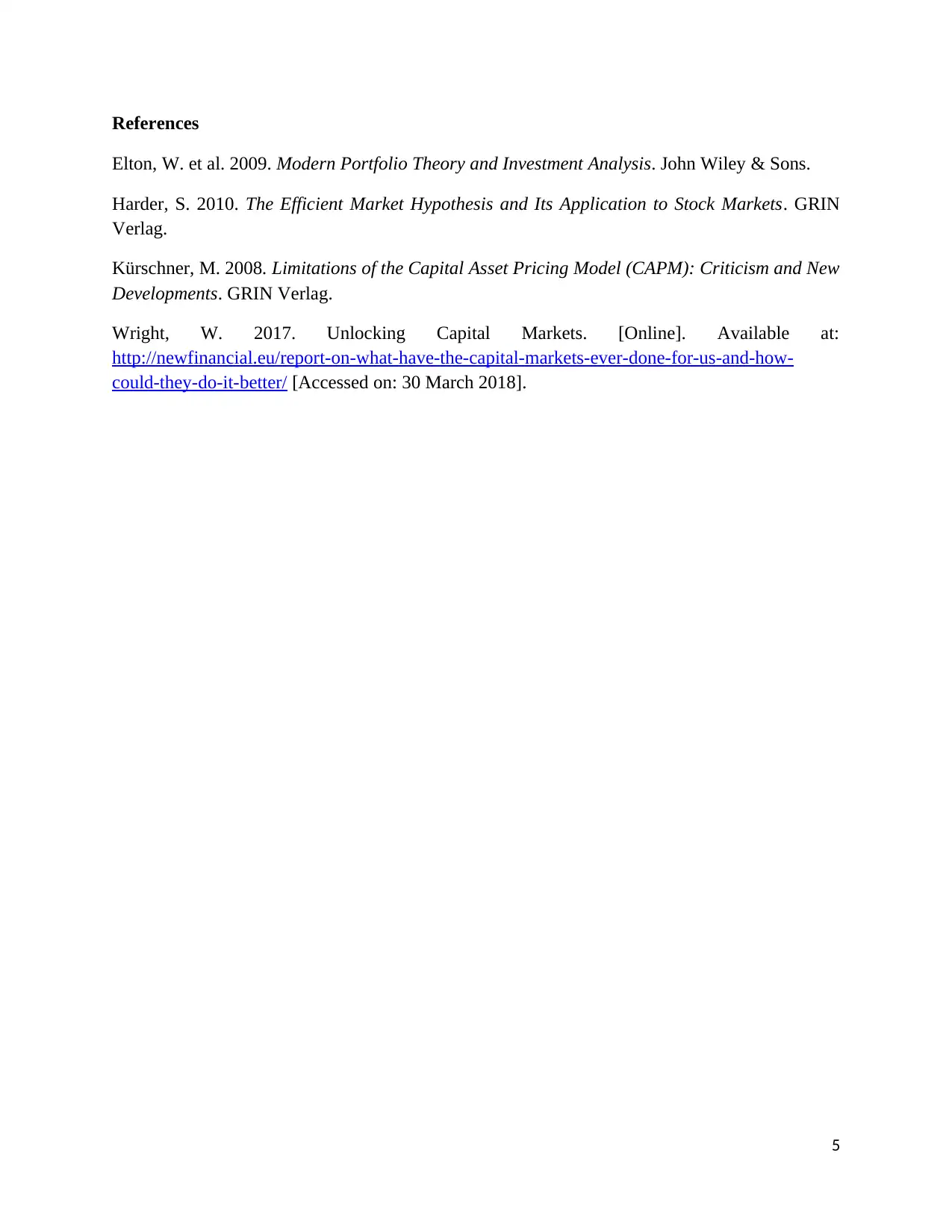Significance of EMH and CAPM in UK Financial Markets Today
VerifiedAdded on 2023/06/13
|5
|942
|409
Report
AI Summary
This report provides an analysis of the Efficient Market Hypothesis (EMH) and the Capital Asset Pricing Model (CAPM) and their relevance to the UK financial markets. It discusses the fundamental features of EMH, highlighting its use in understanding stock price movements based on available information, while acknowledging its limitations in explaining abnormal returns. The report then examines the effectiveness of the CAPM model in determining the relationship between expected return and risk, particularly its ability to measure systematic risk. It also addresses the limitations of the CAPM model, such as its assumptions about borrowing rates and investor behavior, while concluding that both EMH and CAPM are valuable tools for investors in making informed decisions in the UK financial landscape. Desklib offers a repository of similar solved assignments for students.

Finance
1
1
Paraphrase This Document
Need a fresh take? Get an instant paraphrase of this document with our AI Paraphraser

Introduction
The present report is developed for providing an understanding of the financial markets
in the UK through the use of theories of Efficient Market Hypothesis (EMH) and Capital Asset
Pricing Model (CAPM). The financial markets in the UK refer to the capital market involved in
buying and selling of long-term debt and equity securities. The UK capital markets play a major
role in promoting the economic growth and prosperity and thus are a strategic asset for the
country. It has been estimated that about £4 trillion of capital is invested in the financial markets
in the form of pension funds, insurance policies and individual savings (Wright, 2017). In this
context, the major motivation behind undertaking the present report is to evaluate the
significance of EMH and CAPM to the UK financial markets. The research report seeks to
address the following research question:
‘What is the fundamental features of EMH and CAPM and their significance in the UK financial
markets in the 21se century’?
Fundamentals of EMH and its Relevance to UK Financial Market
The theory of EMH is a type of investment theory as per which the price of an asset fully
reflects the available information and thus it is not possible the market by the investors. Thus, as
per the theory the investors cannot realize higher market returns by predicting the stock
movements on the basis of current and past information. This is because all the information is
quickly absorbed in the stock prices and therefore all the investors would realize similar returns.
The main criticism of the theory is that its inefficiency in providing an explanation regarding the
abnormal returns realized by investors through the use of past, present and future information.
However, despite this drawback the theory is used for predicting the movement in asset prices
and its weak form is used in technical analysis. The UK capital market is till using the theory of
EMH due to its continued dominance in the market for analyzing the price changes in the stock
prices. The theory is providing an effective theoretical context for gaining an understanding of
the movements in stock prices as per the financial information. The practical application of the
theory is limited as it is not able to determine the returns to be realized by an investor on the
basis of risk taken (Harder, 2010).
Effectiveness of the CAPM model
2
The present report is developed for providing an understanding of the financial markets
in the UK through the use of theories of Efficient Market Hypothesis (EMH) and Capital Asset
Pricing Model (CAPM). The financial markets in the UK refer to the capital market involved in
buying and selling of long-term debt and equity securities. The UK capital markets play a major
role in promoting the economic growth and prosperity and thus are a strategic asset for the
country. It has been estimated that about £4 trillion of capital is invested in the financial markets
in the form of pension funds, insurance policies and individual savings (Wright, 2017). In this
context, the major motivation behind undertaking the present report is to evaluate the
significance of EMH and CAPM to the UK financial markets. The research report seeks to
address the following research question:
‘What is the fundamental features of EMH and CAPM and their significance in the UK financial
markets in the 21se century’?
Fundamentals of EMH and its Relevance to UK Financial Market
The theory of EMH is a type of investment theory as per which the price of an asset fully
reflects the available information and thus it is not possible the market by the investors. Thus, as
per the theory the investors cannot realize higher market returns by predicting the stock
movements on the basis of current and past information. This is because all the information is
quickly absorbed in the stock prices and therefore all the investors would realize similar returns.
The main criticism of the theory is that its inefficiency in providing an explanation regarding the
abnormal returns realized by investors through the use of past, present and future information.
However, despite this drawback the theory is used for predicting the movement in asset prices
and its weak form is used in technical analysis. The UK capital market is till using the theory of
EMH due to its continued dominance in the market for analyzing the price changes in the stock
prices. The theory is providing an effective theoretical context for gaining an understanding of
the movements in stock prices as per the financial information. The practical application of the
theory is limited as it is not able to determine the returns to be realized by an investor on the
basis of risk taken (Harder, 2010).
Effectiveness of the CAPM model
2

The model of CAPM is being used widely in the 21set century for determining the
relation between expected return and the underlying risk associated with a stock price. The
model is being widely used at present in the UK capital market due to its effectiveness in
determining the cost of equity and relating the trade-off between the risk and return. It is able to
prove an accurate measure of the systematic risk that is not provided by other investment
analysis model such as EMH. The systematic risk is known un-diversifiable risk or market risk
that cannot be eliminated by an investor as it refers to the volatility in the stock prices due to
daily fluctuations. The CAPM model has determined effectively the relation between the
required return to be realized from an investment and the associated risk (Elton et al., 2009). The
formula used for calculating the return on a financial asset provided by CAPM model is as
follows:
The model is extensively used in the financial market analysis in the UK for determining
the security returns in comparison to the changes in the capital market. The yield of UK Treasury
bill is also calculated through the use of CAPM model due to its effectiveness in appropriately
determining the risk-free rate of return. In addition to this, the ease of use of the model and its
effectiveness in carrying its financial analysis in different variable business conditions is also
responsible for its larger use in the UK capital market at present. However, some of the
limitations of the method such as its key assumption of borrowing and lending money at risk-free
rate can impact the outcome obtained through the use of the model. Also, the assumption
regarding the nature of investors is not attainable in real life situations. As such, these key
assumptions taken in the model can impact its effectiveness. However, the absence of a better
model in the corporate finance for determining the relation between risk and market returns is
causing larger use of CAPM model at present (Kürschner, 2008).
Conclusion
3
relation between expected return and the underlying risk associated with a stock price. The
model is being widely used at present in the UK capital market due to its effectiveness in
determining the cost of equity and relating the trade-off between the risk and return. It is able to
prove an accurate measure of the systematic risk that is not provided by other investment
analysis model such as EMH. The systematic risk is known un-diversifiable risk or market risk
that cannot be eliminated by an investor as it refers to the volatility in the stock prices due to
daily fluctuations. The CAPM model has determined effectively the relation between the
required return to be realized from an investment and the associated risk (Elton et al., 2009). The
formula used for calculating the return on a financial asset provided by CAPM model is as
follows:
The model is extensively used in the financial market analysis in the UK for determining
the security returns in comparison to the changes in the capital market. The yield of UK Treasury
bill is also calculated through the use of CAPM model due to its effectiveness in appropriately
determining the risk-free rate of return. In addition to this, the ease of use of the model and its
effectiveness in carrying its financial analysis in different variable business conditions is also
responsible for its larger use in the UK capital market at present. However, some of the
limitations of the method such as its key assumption of borrowing and lending money at risk-free
rate can impact the outcome obtained through the use of the model. Also, the assumption
regarding the nature of investors is not attainable in real life situations. As such, these key
assumptions taken in the model can impact its effectiveness. However, the absence of a better
model in the corporate finance for determining the relation between risk and market returns is
causing larger use of CAPM model at present (Kürschner, 2008).
Conclusion
3
⊘ This is a preview!⊘
Do you want full access?
Subscribe today to unlock all pages.

Trusted by 1+ million students worldwide

Thus, it can be said from the overall discussion that EMH and CAPM model are both
used by investors for investment decisions. The theory of EMH provides a theoretical context
while CAPM is useful for determining a quantitative relation between risk and market returns.
4
used by investors for investment decisions. The theory of EMH provides a theoretical context
while CAPM is useful for determining a quantitative relation between risk and market returns.
4
Paraphrase This Document
Need a fresh take? Get an instant paraphrase of this document with our AI Paraphraser

References
Elton, W. et al. 2009. Modern Portfolio Theory and Investment Analysis. John Wiley & Sons.
Harder, S. 2010. The Efficient Market Hypothesis and Its Application to Stock Markets. GRIN
Verlag.
Kürschner, M. 2008. Limitations of the Capital Asset Pricing Model (CAPM): Criticism and New
Developments. GRIN Verlag.
Wright, W. 2017. Unlocking Capital Markets. [Online]. Available at:
http://newfinancial.eu/report-on-what-have-the-capital-markets-ever-done-for-us-and-how-
could-they-do-it-better/ [Accessed on: 30 March 2018].
5
Elton, W. et al. 2009. Modern Portfolio Theory and Investment Analysis. John Wiley & Sons.
Harder, S. 2010. The Efficient Market Hypothesis and Its Application to Stock Markets. GRIN
Verlag.
Kürschner, M. 2008. Limitations of the Capital Asset Pricing Model (CAPM): Criticism and New
Developments. GRIN Verlag.
Wright, W. 2017. Unlocking Capital Markets. [Online]. Available at:
http://newfinancial.eu/report-on-what-have-the-capital-markets-ever-done-for-us-and-how-
could-they-do-it-better/ [Accessed on: 30 March 2018].
5
1 out of 5
Related Documents
Your All-in-One AI-Powered Toolkit for Academic Success.
+13062052269
info@desklib.com
Available 24*7 on WhatsApp / Email
![[object Object]](/_next/static/media/star-bottom.7253800d.svg)
Unlock your academic potential
Copyright © 2020–2025 A2Z Services. All Rights Reserved. Developed and managed by ZUCOL.





